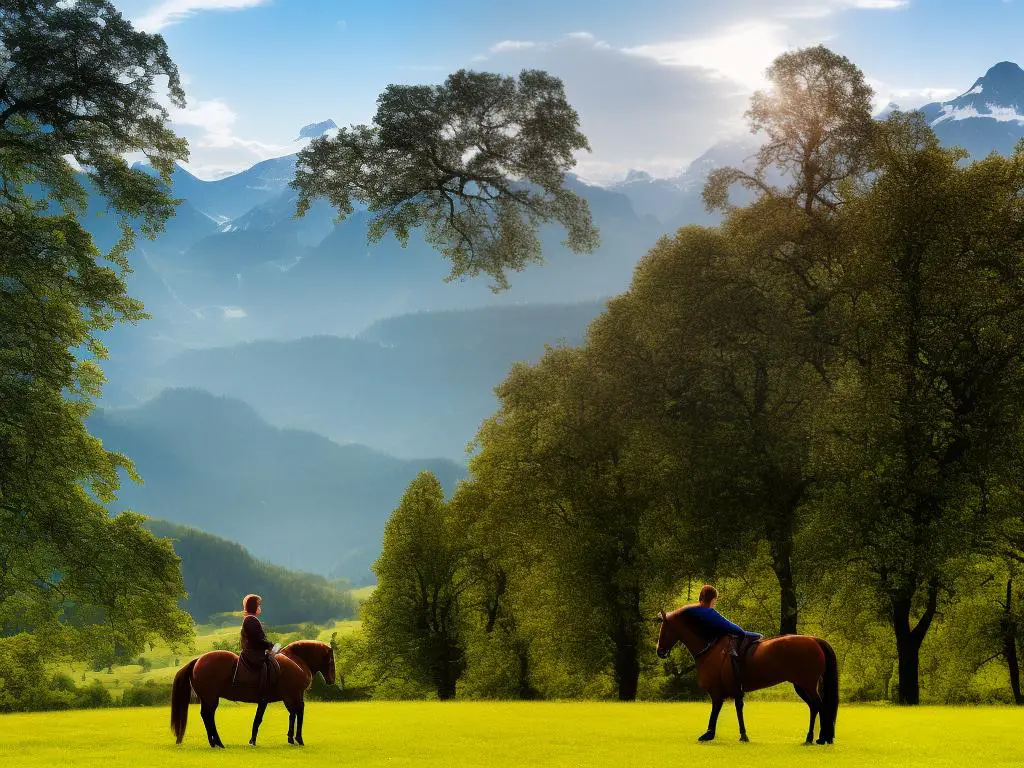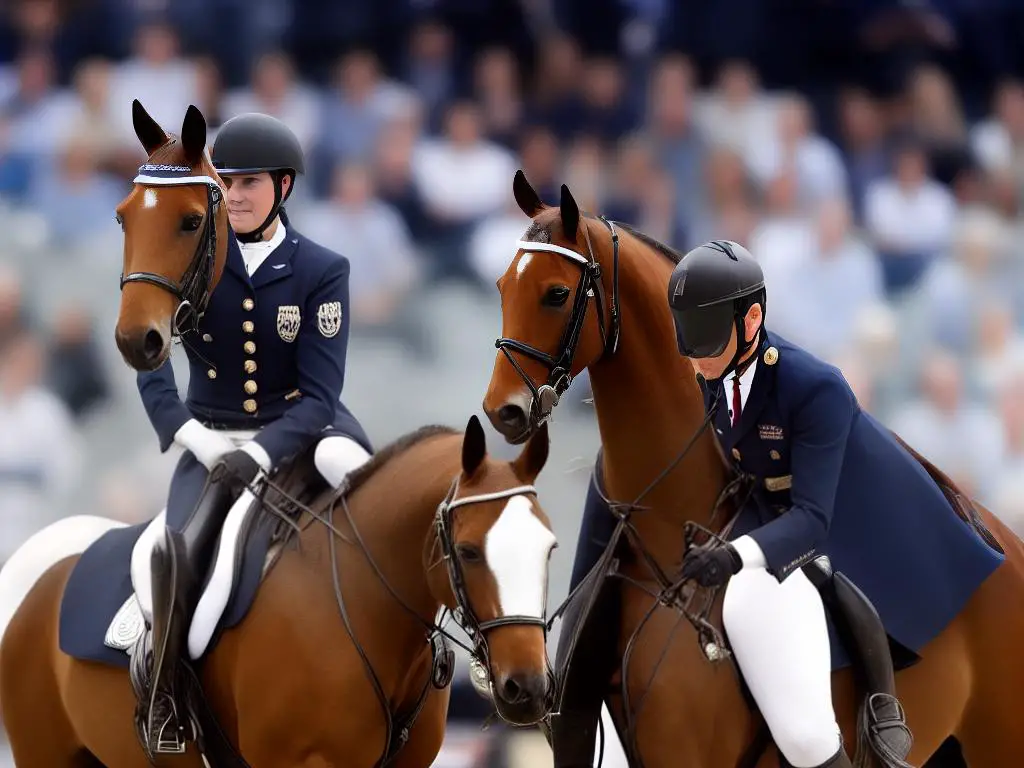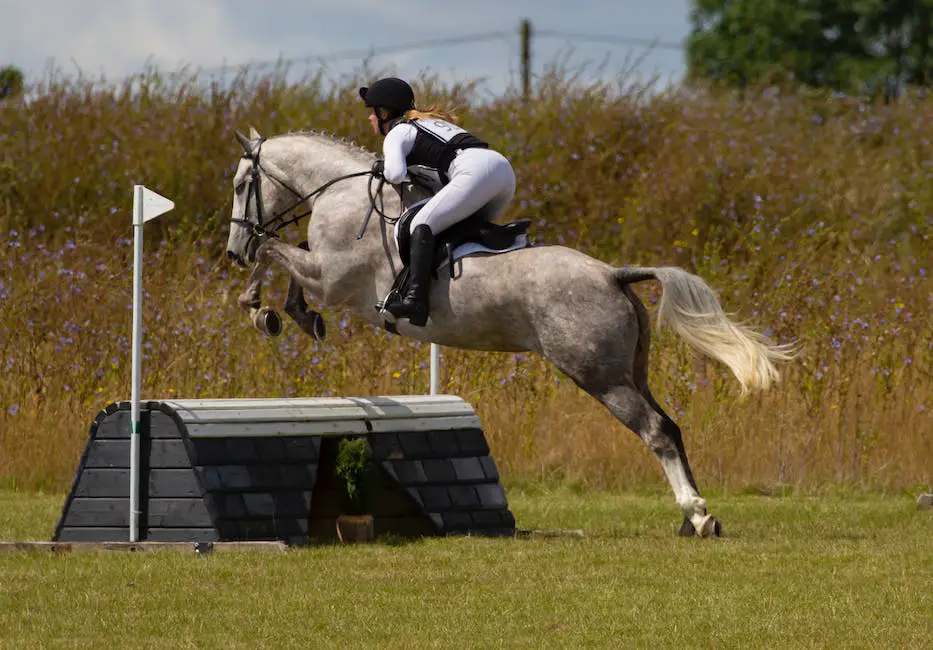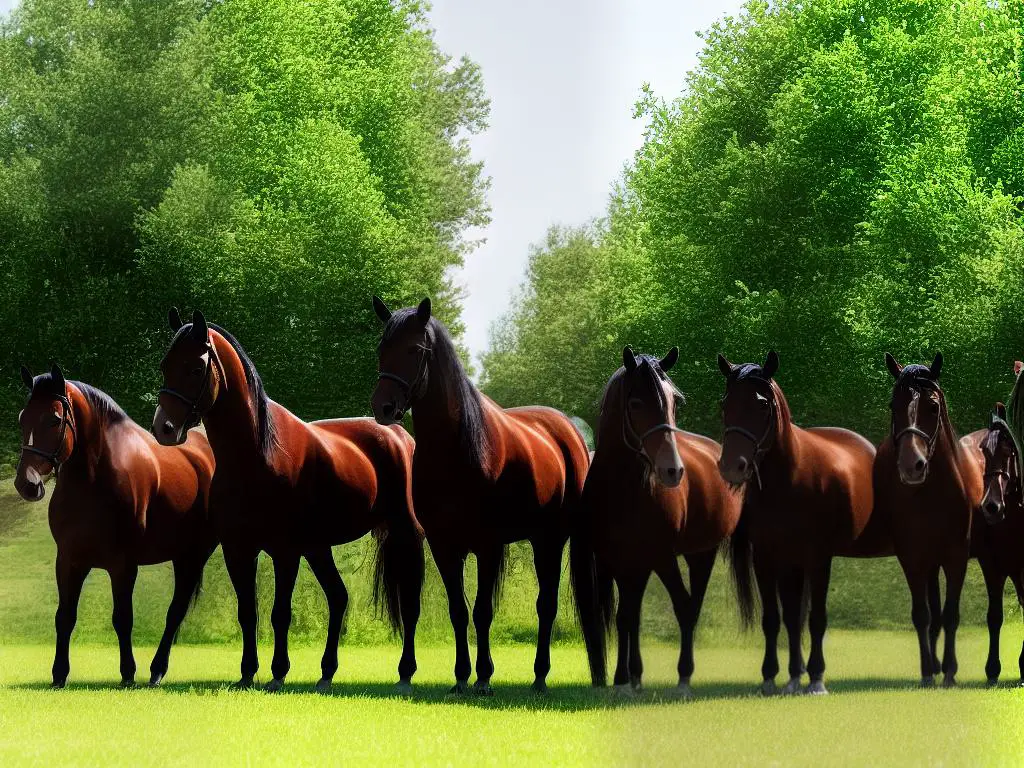Renowned for their athletic agility, remarkable versatility, and captivating charm, the German Riding Pony has emerged as a beloved breed amongst equestrian enthusiasts worldwide. Born out of a clear vision to create an exceptional pony breed that possesses the stature of a horse while maintaining the petite size suitable for young riders, the German Riding Pony’s history tells a tale as fascinating as the breed itself. This immersive exploration delves into the intriguing origins, rich history, distinctive characteristics, and crucial care regimens necessary for these exquisite animals.
Table of Contents (Horspedia)
Origins and History of the German Riding Pony
Origins and Development of the German Riding Pony
The German Riding Pony, an intriguing high-performance equine breed, originated in Germany during the 1960s and 1970s. As the demand for athletic, high-performing yet gentle and manageable horses grew across Europe and the globe, breeders sought to develop a pony breed that possessed these qualities. In essence, the German Riding Pony was conceived as a “miniature warmblood,” encapsulating the grace, power, and temperament of larger horses within a manageable size for younger or smaller riders.
Post-war Europe saw an increase in leisure activities, including horse riding. This surge in interest for equestrian events, particularly among young riders, contributed to the breeding of the German Riding Pony. Germany had a long-established tradition of horse breeding, led by numerous private stud farms and state-owned stud farms. They sought to develop a breed of pony that could compete in dressage, showjumping, and cross-country events yet be suitable for children and teenagers through their calm temperament and manageable size.
Breeding stock for the German Riding Pony primarily came from native German pony breeds like the Shetland pony and the New Forest pony. These native breeds were crossbred with small horses and larger pony breeds, including the Jutland horse, the Welsh Pony, and the Anglo-Arabian horse, to create a new, modern breed that maintained the desired athletic qualities but at a smaller stature.
A Breed Apart: Characteristics and Comparisons of the German Riding Pony
In comparison to other pony breeds, the German Riding Pony stands out due to their excellent athletic abilities, docile temperament, and beauty. Unlike traditional pony types, the German Riding Pony mimics the presence and style of a full-size horse. These ponies are well-proportioned, characterized by a sizable, expressive head, a well-set neck, long legs, and a muscular back. They generally stand between 13.2 and 14.2 hands high, making them an ideal size for young riders transitioning from smaller ponies to larger horses.
Despite their relatively small size or stature, German Riding Ponies are known for their impressive athletic capabilities. They excel in various equestrian disciplines, including dressage, show jumping, and eventing. These ponies have an excellent, rhythmic trot, a strong canter, natural jumping ability, and inherent agility.
In terms of temperament, German Riding Ponies are intelligent, friendly, and willing to work. Their calm and mild temperament makes them suitable for young or less experienced riders, while their intelligence and willingness to perform also make them a popular choice for competitive young riders and small adults.
A Deep Dive into the German Riding Pony Breed
German Riding Ponies have fundamentally shaped the equestrian world with their impressive performances in youth dressage championships and international pony competitions. Renowned for their athletic ability, versatility, and trainability, these ponies are not just the epitome of performance but also enhance the accessibility and appeal of equestrian sports for younger or smaller audience. Their successful integration into equestrian sports underscores their significance and confirms their influence. Combining athleticism, beauty, and temperament, German Riding Ponies have marked their presence with grandeur in the equestrian realm and continue to stand out.

Characteristics and Traits of the German Riding Pony
Unraveling the Unique Physical Traits of German Riding Ponies
German Riding Ponies, also referred to as “das Deutsche Reitpony,” impress with a sublime blend of grace, power, and size. With heights ranging from 13.2 to 14.2 hands, these ponies offer the perfect riding companions for youngsters and smaller adults. Mimicking the build of a miniaturised Warmblood horse, these ponies are purposefully designed to tackle competitive equestrian challenges. Their refined heads featuring large expressive eyes, well-proportioned necks, distinct withers, robust backs, and sloping croups contribute to their aesthetic appeal. Unlike many other pony breeds, German Riding Ponies stand out with their proportionately longer legs, ensuring superior movement and jumping abilities.
Varieties in Coat Color
In terms of color, the German Riding Pony presents a broad spectrum of possibilities. Common varieties include bay, grey, chestnut, black, and palomino, yet they can showcase a range of other shades and patterns. The breed is known for its shiny, full and beautiful mane, tail, and coat which often attract attention in horse shows and competitions.
Personality Traits and Temperament
Like many German breeds, the German Riding Pony is praised for its exceptional temperament. They are well-known for their intelligence, strength, and versatility, encompassing commendable qualities of both horse and pony. These characteristics make them ideal for various equestrian activities, including dressage, show jumping, eventing, and driving.
The German Riding Pony is also recognized for being calm, friendly, and remarkably trainable. Despite their size, they are not intimidated easily, showcasing a level of bravery that is essential on the riding field. Their level-headed nature doesn’t compromise their liveliness; they are energetic and spirited, yet not overly so. In the hands of a moderately experienced trainer, these equine prodigies tend to learn quickly and perform brilliantly.
An Introduction to the German Riding Pony
The German Riding Pony, known for its striking resemblance to German Warmbloods, is a breed that stands out due to its horse-like qualities but in a much smaller package. These ponies boast a large stride, exceptional jumping technique, and notable stamina, abilities that allow them to compete against larger breeds effectively.
Their adaptability and versatility serve them well in any environment, demonstrating their robustness through all weather conditions and establishing their significant place in the equestrian world.
Beyond physical attributes, German Riding Ponies consistently deliver impressive athletic performances. The reliability of this breed at both regional and international events has not gone unnoticed, and the combination of their determination, elegance, and stamina makes them a top pick for both competitive and leisure riding.

Training and Handling German Riding Ponies
Delving Deeper into the German Riding Pony Breed
Also known as the Deutsches Reitpony, the German Riding Pony is celebrated for its capability, agility, and athleticism. Originating from Germany, this breed has gained fame due to its remarkable performance in various equestrian disciplines such as dressage, jumping, and driving. Consequently, German Riding Ponies have earned considerable recognition and respect on the European pony competition scene.
Training German Riding Ponies
Training your German Riding Pony isn’t too different from other pony breeds. It has an exceptional knack for learning, but firmness and consistency are key. Their intelligence makes it easier to train, but they can also quickly pick up bad habits if not properly guided.
Positive reinforcement techniques work best with this breed. Whenever the pony exhibits a preferred behavior, immediacy of rewards like treats or praise is crucial. Remember, these ponies appreciate mental stimulation, so training sessions involving various activities avoid monotony.
Challenges in Handling German Riding Ponies
Although they’re generally easy to handle, German Riding Ponies can sometimes be strong-willed or stubborn. Owners might experience issues during training if a tactful, consistent approach isn’t maintained. The key is to establish yourself as a reliable, understanding leader.
Another challenge might be their agility and speed. German Riding Ponies are highly energetic and need regular exercise. Without it, they may be harder to handle or become anxious.
Versatility in Equestrian Events
German Riding Ponies shine in competitive events like dressage, jumping, and driving. Their agility, athleticism, and stamina allow these ponies to excel in high-intensity activities.
- In dressage, their smooth gaits and natural balance make them optimal mounts.
- For jumping, their quick response and high energy level provide strong performance.
- Their power and speed make them equally efficient in driving sports.
Tips for Effective Training
- Keep training sessions short and varied to keep your pony mentally stimulated.
- Regularly socialize them with other horses to prevent behavioral issues.
- Allow them adequate time to rest and relax, as overworking can lead to stress and burnout.
- Always ensure a proper diet; certain deficiencies can affect their performance.
Conclusion
German Riding Ponies, known for their intellect, energy, and athleticism, are a popular choice among equine enthusiasts. These characteristics, along with their versatility and adaptability, render them ideal for various equestrian events. With carefully structured training and attentive care, you can cultivate a relationship with a remarkably skilled and dependable German Riding Pony.

Feeding, Care, and Health of German Riding Ponies
Nutrition and Feeding for German Riding Ponies
The dietary requirements of German Riding Ponies depend on factors like the current season, their activity level, and age. Nonetheless, a nutritionally balanced diet is essential for their well-being. Their primary diet should be composed of considerable forage such as hay and grass, not only to satisfy their natural grazing habits but to also aid in the maintenance of their digestive health. Regular servings of concentrate feeds like oats, barley, and maize are also beneficial, but should be gradually introduced to prevent bloating or choking.
Compared to larger horses, ponies require a diet with lesser protein content. Overconsumption of protein can trigger obesity and metabolic disorders, hence the importance of a diet rich in essential vitamins and minerals. Furthermore, constant access to clean, fresh water is paramount for these ponies.
German Riding Ponies Health Issues
Like all equines, German Riding Ponies are prone to certain health issues. These include laminitis which is inflammation of the laminae in the hoof, a consequence of overgrazing or high sugar diet, and equine metabolic syndrome, resulting from obesity. Regular exercises and controlled diet can help prevent these conditions.
Periodic health check-ups ensure that any signs of health issues can be detected early on. Regular vaccinations for diseases such as equine flu, tetanus, and other potential health threats like worms and ticks are a necessity.
Their dental health is as important as their overall wellbeing, hence, routine dental checks and floats are mandatory to keep them from developing issues like sharp edges, hooks, and abnormal wear patterns that can affect their eating capability and overall comfort.
Care Guidelines for German Riding Ponies
The care of a German Riding Pony doesn’t differ too much from smaller horses or large ponies. Grooming is an important aspect of their care since it helps keep their coat, mane, and tail clean, shiny, and free from parasites, and it also encourages blood circulation to the surface of the skin. Regular hoof care which includes cleaning, trimming, and shoeing (if necessary) by a qualified farrier is paramount to prevent lameness and other hoof-related disorders.
German Riding Ponies require regular exercise to ensure physical and mental stimulation. Sufficient pasture space for free roaming and play, along with structured exercise routines such as riding, lunging, or driving can help maintain their optimal health and wellbeing.
They also require secure and clean stabling with appropriate bedding to guarantee comfort and ease during their rest periods.
Longevity and Overall Well-being
German Riding ponies usually enjoy a long lifespan of up to 30 years with proper care. Providing a nutritious diet, maintaining an adequate exercise regime, ensuring regular health checks, and offering lots of social interaction with humans and other horses can enhance their overall well-being ensuring their longevity.
Understanding and adapting to the individual needs and behaviors of German riding ponies ensures their overall well-being, making them happy, healthy, and a pleasure to ride or drive.

Whether it’s their refined physique, spirited temperament, impressive adaptability, or their amiable companionship, there are many reasons why the German Riding Pony has captured so many hearts. As with any animal, understanding their unique needs and providing for them accordingly is the key to a healthy, long-lived, and mutually rewarding relationship. From insightful details about their past to detailed guidance on effective training, feeding, and care, enriched knowledge empowers every German Riding Pony owner to enhance and preserve the essence of this exceptional breed in all its beauty and vitality.
